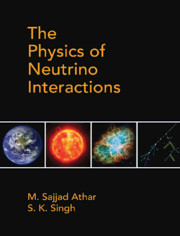Book contents
- Frontmatter
- Dedication
- Contents
- List of Figures
- List of Tables
- Preface
- Acknowledgments
- Chapter 1 Neutrino Properties and Its Interactions
- Chapter 2 Relativistic Particles and Neutrinos
- Chapter 3 Quantization of Free Particle Fields
- Chapter 4 Interacting Fields and Relativistic Perturbation Theory
- Chapter 5 Phenomenological Theory I: Nuclear β-decays and Weak Interaction of Leptons
- Chapter 6 Phenomenological Theory II: Weak Decays of Hadrons
- Chapter 7 Gauge Field Theories and Fundamental Interactions
- Chapter 8 Unified Theory of Electroweak Interactions
- Chapter 9 Neutrino and Electron Scattering from Point Particles
- Chapter 10 Neutrino scattering Cross Sections from Hadrons: Quasielastic Scattering
- Chapter 11 Neutrino Scattering from Hadrons: Inelastic Scattering (I)
- Chapter 12 Neutrino Scattering from Hadrons: Inelastic Scattering (II)
- Chapter 13 Neutrino Scattering from Hadrons: Deep Inelastic Scattering
- Chapter 14 Weak Quasielastic v(⊽)-nucleus Scattering
- Chapter 15 Inelastic Scattering of (Anti)neutrinos from Nuclei
- Chapter 16 Deep Inelastic Scattering of (Anti)neutrinos from Nuclei
- Chapter 17 Neutrino Sources and Detection of Neutrinos
- Chapter 18 Neutrino Mixing and Oscillations
- Chapter 19 Neutrino Astrophysics and the Synthesis of Elements
- Chapter 20 Neutrino Interactions Beyond the Standard Model
- Appendices
- Appendix A Lorentz Transformation and Covariance of the Dirac Equation
- Appendix B Cabibbo Theory
- Appendix C Some Properties of Pauli and Dirac Matrices and Spin Density Matrices
- Appendix D Leptonic and Hadronic Tensors
- Appendix E General Expression for the Total Scattering Cross Section and Decay Rates
- Appendix F Expressions of N(q2), the Coefficients of the Polarization Observables
- References
- Index
Chapter 16 - Deep Inelastic Scattering of (Anti)neutrinos from Nuclei
Published online by Cambridge University Press: 22 May 2020
- Frontmatter
- Dedication
- Contents
- List of Figures
- List of Tables
- Preface
- Acknowledgments
- Chapter 1 Neutrino Properties and Its Interactions
- Chapter 2 Relativistic Particles and Neutrinos
- Chapter 3 Quantization of Free Particle Fields
- Chapter 4 Interacting Fields and Relativistic Perturbation Theory
- Chapter 5 Phenomenological Theory I: Nuclear β-decays and Weak Interaction of Leptons
- Chapter 6 Phenomenological Theory II: Weak Decays of Hadrons
- Chapter 7 Gauge Field Theories and Fundamental Interactions
- Chapter 8 Unified Theory of Electroweak Interactions
- Chapter 9 Neutrino and Electron Scattering from Point Particles
- Chapter 10 Neutrino scattering Cross Sections from Hadrons: Quasielastic Scattering
- Chapter 11 Neutrino Scattering from Hadrons: Inelastic Scattering (I)
- Chapter 12 Neutrino Scattering from Hadrons: Inelastic Scattering (II)
- Chapter 13 Neutrino Scattering from Hadrons: Deep Inelastic Scattering
- Chapter 14 Weak Quasielastic v(⊽)-nucleus Scattering
- Chapter 15 Inelastic Scattering of (Anti)neutrinos from Nuclei
- Chapter 16 Deep Inelastic Scattering of (Anti)neutrinos from Nuclei
- Chapter 17 Neutrino Sources and Detection of Neutrinos
- Chapter 18 Neutrino Mixing and Oscillations
- Chapter 19 Neutrino Astrophysics and the Synthesis of Elements
- Chapter 20 Neutrino Interactions Beyond the Standard Model
- Appendices
- Appendix A Lorentz Transformation and Covariance of the Dirac Equation
- Appendix B Cabibbo Theory
- Appendix C Some Properties of Pauli and Dirac Matrices and Spin Density Matrices
- Appendix D Leptonic and Hadronic Tensors
- Appendix E General Expression for the Total Scattering Cross Section and Decay Rates
- Appendix F Expressions of N(q2), the Coefficients of the Polarization Observables
- References
- Index
Summary
Introduction
We have discussed charged lepton and (anti)neutrino induced deep inelasticscattering (DIS) off free protons in Chapter 13. The interaction crosssection and the structure functions of nucleons are modified when thescattering takes place from the nucleons bound inside a nucleus. Thereactions are shown in Figure 16.1, where l =e, μ. A is thetarget nucleus and X is the jet of hadrons are the fourmomenta of the initial and the final state particles respectively.Historically, the first observations of modifications of the nuclearstructure
functions were made by the European Muon Collaboration (EMC) at CERN in1981–83. The EMC collaboration studied the ratio of structurefunction F2(x,Q2) per nucleon for iron to deuteriumtargets, that is in the energy region of 120-280 GeV and its deviation fromunity. This effect is known as the EMC effect. Since then, the EMC effecthas been confirmed and studied with improved precision in many DISexperiments using electrons, muons [783, 784, 785, 786, 787, 788],neutrinos, and antineutrinos [789, 790, 791, 792, 793, 794] from differentnuclear targets as well as in the Drell–Yan processes using protonand pions [795, 796, 797]. Some of these results are presented in Figure16.2. From the figure, it may be observed that the ratio is different fromunity in almost the entire region of the Bjorken scaling variable 0< x < 1. From these experiments, somegeneral features of the ratio R(x,Q2) may be inferred:
• The x dependence ofR(x,Q2) has considerable structure, thatis, it is different in different regions of x.
• The shape of the effect is almost independent ofA.
• The functional form ofR(x,Q2) is relatively independent in theregion of high Q2.
Generally, the nuclear medium effects manifested through the ratioR(x, Q2)are broadly divided into four regions of x in which thex dependence is attributed to different physicaleffects.
- Type
- Chapter
- Information
- The Physics of Neutrino Interactions , pp. 632 - 668Publisher: Cambridge University PressPrint publication year: 2020

